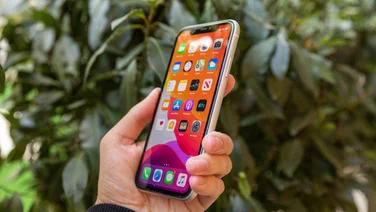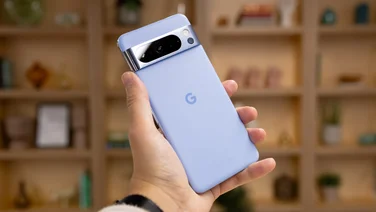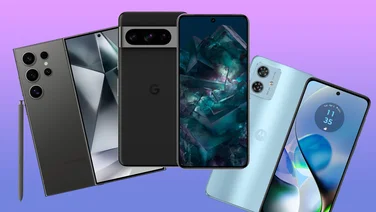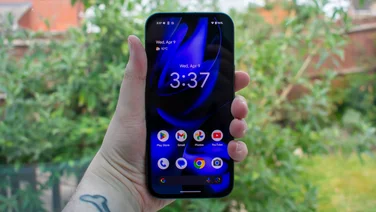To help us provide you with free impartial advice, we may earn a commission if you buy through links on our site. Learn more























- Cheapest ultra-slim phone yet
- Incredibly thin and lightweight build
- Decent trio of cameras
- No telephoto camera
- Only four OS updates
- Performance is only okay
The Motorola Edge 70 is something of a reimagining, taking one of the brand’s longest-running smartphone lines in a new, decidedly more literal direction. With the Razr name otherwise occupied, it falls to the Edge series to represent Motorola in the burgeoning market for ultra-slim phones.
While the first couple of swings at this format have been very expensive, the Edge 70 shoots for a more accessible price point, delivering the cheapest of these super-svelte smartphones by quite some margin. Given that so far, this potential fad has been something of a false start, that seems like a very smart move.
I don’t view the Edge 70 as an unmitigated success, however. The lack of a telephoto camera continues to be the Achilles’ heel of ultra-thin phones, and the slimline build comes at the expense of performance speeds. Even still, the Motorola Edge 70 is incredibly skinny and bafflingly light – on those merits, it succeeds. Moreover, it’s the best ultra-slim smartphone yet, albeit only by virtue of not costing as much money as the others.
What you need to know
So far, skinny smartphones have been somewhat dead on arrival. According to analysts, neither the Apple iPhone Air nor the Samsung Galaxy S25 Edge have sold particularly well, with the latter’s struggles being linked to Samsung delaying the release of the Galaxy S26 series.























This very much tracks with my impression of the first two ultra-slim smartphones that we’ve tested: they have impressive designs and feel wonderful to hold, but the sacrifices made to achieve the slim build simply don’t merit such a high price tag. This format isn’t like foldables, where it gets you a unique level of functionality; it’s a gimmick, and should be treated as such.
Motorola seems to understand that more than Samsung or Apple. The Edge 70 isn’t cheap by any means, but it is at least headed in the right direction – closer to mid-range prices than trying to be a four-figure flagship.
And best of all, there’s still plenty of quality here. The display is a 6.7in pOLED screen with a resolution of 2,712 x 1,220 and a 120Hz refresh rate. The Snapdragon 7 Gen 4 processor is backed by 12GB of RAM and 512GB of storage, and, most notably, the battery is a 4,800mAh cell, which is much larger than we’ve seen on other skinny smartphones.























There’s no telephoto camera, which is a shame, but we do get three 50-megapixel lenses; on the rear are the main camera and an ultrawide shooter, while the sharp selfie camera sits in a hole-punch notch at the top of the display.
Price and competition
There’s only one model of the Edge 70 coming to the UK, with 12GB of RAM and 512GB of onboard storage, and it will cost you £699. That’s quite a bit more than the Edge 60, but substantially cheaper than the other ultra-slim phones on the market.
The Samsung Galaxy S25 Edge is the next cheapest, starting at £899 for the 256GB model or costing £999 for the 512GB version. The iPhone Air, meanwhile, starts at £999 for 256GB of storage, and you can also get 512GB for £1,199 or 1TB for a hefty £1,399.























At the same £699 as the Edge 70, we have the Honor 400 Pro, which again comes with 12GB of RAM and 512GB of storage. This has more extensive software support and better battery life, but it lacks protective Gorilla Glass and has a much weaker ultrawide camera.
Finally, the Xiaomi 15T Pro also costs £699 for the 512GB variant – there are ostensibly 256GB and 1TB versions, but these are perpetually out of stock. Here, we have excellent performance, a gorgeous display and a crisp 5x telephoto camera, but Xiaomi’s HyperOS software is difficult to love.
Design and key features
In the skinny stakes, Motorola is a comfortable third place – the Edge 70 measures 6mm front to back, whereas the Samsung Galaxy S25 Edge is 5.8mm and the iPhone Air is even slimmer, at 5.6mm.
The iPhone’s victory is somewhat undermined by a relatively chunky camera bump, which is double the thickness of the rest of the phone. By comparison, the Edge 70’s camera housing feels much more molehill than mountain.























The Edge 70 is the lightest of the three, too: it weighs just 159g, undercutting the 163g Galaxy and 165g iPhone. I find lightweight far more appealing than slimness – see also my preference for the Samsung Galaxy Z Fold 7 over the Honor Magic V5 – and really enjoyed the balance the Edge 70 struck here. It felt wonderfully airy in the hand, and there were several times during testing that I forgot it was in my pocket.
As is crucial for these slender phones, it’s nicely robust, too – though it’s here that I start to see the first indications that this is a cheaper product. Where both Samsung and Apple use high-end titanium on the rear and sides, the Motorola Edge 70 pairs a (still impressively solid) aluminium chassis with a “nylon-inspired silicone finish” on the back.
This is one of many unconventional materials that we’ve seen Motorola utilise on recent phones, and it both looks and feels suitably premium – you can really feel the nylon inspiration, with the tiniest amount of friction as you run your finger over the back. It’s unique and interesting, but lacks the inherent peace of mind that you get from a titanium build.























Protection elsewhere is up to scratch: there’s a layer of Gorilla Glass 7i sitting over the display, and the phone is rated IP68/IP69 for dust and water resistance. That means it’s dust-tight and will survive submersion in 1.5m of water for up to 30 minutes, as well as high-pressure, high-temperature jets of water.
Another certainty with Motorola phones is Pantone-approved colours, and we have three here to choose from. The twist is that each has a secondary, complementary colour around the camera lenses and on the AI button – more on that shortly.
Lily Pad is a light, muted green with orange accents, Gadget Grey is basically black and has rich blue accents, and Bronze Green is a vibrant, verdant green with bronze accents. While these contrasting sections help the phone stand out from the hegemony of Motorola’s lineup, they’re a little tacky for my tastes.























The Edge 70 runs Android 16 out of the box and is promised four years of OS updates and six years of security patches. You can get better for less money than this: the Honor 400 Pro, for instance, is set for six years apiece, and the much cheaper Google Pixel 9a is getting seven. Otherwise, this is slick and accessible software for the most part – though there’s more bloatware than I traditionally see on Motorola phones, which I’m not thrilled about.
Moto AI is still a little too scattershot for my liking, too. As it stands, pressing and holding the AI button on the left edge hails Moto AI, giving you the usual selection of features like transcribing, image generation and asking questions with Copilot. Holding the power button, however, engages Google’s Gemini AI, which is confusing. It would be great to see Gemini better integrated into Moto AI for a more streamlined, user-friendly interface.
Display
The 6.7in pOLED display is identical to the one on last year’s Motorola Edge 60 Pro, with a crisp 2,712 x 1,220 resolution and peak refresh rate of 120Hz. It’s still not an LTPO panel, so it can’t dynamically adjust down to 1Hz for improved power efficiency, but it otherwise ticks all the boxes.
Brightness is decent, hitting 474cd/m2 on manual mode and rising to 1,060cd/m2 on adaptive brightness with a torch shining on the light sensor. When displaying HDR content, it topped out at a dazzling 1,371cd/m2.























We’ve got Motorola’s three colour profiles here, with Vivid and Radiant offering different levels of saturation to make your streaming and gaming pop, while Natural aims for authentic colour reproduction. On the latter, I recorded an sRGB gamut coverage of 98.7% against a volume of 101.3%, with the 1.32 average Delta E score speaking to decent, if not perfect, colour accuracy.
Performance and battery life
Easily the biggest area of compromise compared to other ultra-slim smartphones is the processor. The Qualcomm Snapdragon 7 Gen 4 isn’t a bad chipset, but both the Galaxy S25 Edge and iPhone Air are fitted with flagship processors and stormed ahead in our performance tests.
The slightly chunkier competition around this price also outperforms the Motorola Edge 70 by quite some distance. The Honor 400 Pro’s results were 56% better than the Edge 70 in the single-core results and 45% in the multi-core, while the Xiaomi 15T Pro was even better, scoring 98% and 91% higher than the Edge, respectively.
While the Motorola Edge 70 is nippy, hopping between apps without lagging and keeping operations smooth with multiple apps open, its results are closer to those of the Google Pixel 9a. This isn’t a great look, given that the Pixel 9a is available for hundreds of pounds less.
Equally, the Motorola Edge 70 is fine for gaming, but there are plenty of better options. I ran Asphalt Legends for a few rounds and found framerates to be consistent and textures to be decently sharp, but anything more intensive may struggle.
As you can see below, you can get far better gaming chops from the competition. Even ignoring the more expensive iPhone Air and Galaxy S25 Edge, the Honor 400 Pro delivers offscreen framerates almost twice those of the Motorola Edge 70.
I felt the lack of a flagship processor – and the superior power efficiency contained therein – with the battery life, too. Despite having a significantly larger battery, the Motorola Edge 70 didn’t last as long as either the S25 Edge or iPhone Air in our looping video battery test, tapping out after 25hrs 47mins.
That’s still decent, however, and will happily see you through a full day of moderate screen-on time with something left in the tank at bedtime.
Charging supports up to 68W wired and 15W wireless. Plugged in, I saw the Edge 70 go from empty to 50% in around 19 minutes, with a full charge taking 48 minutes. That’s pretty swift, especially compared to the competition – both the Galaxy S25 Edge and iPhone Air take over an hour to hit 100% – but the phone does get rather warm during charging.
Cameras
The lack of a telephoto camera continues to be my biggest concern with these ultra-slim phones, but that omission does at least feel a little less egregious here than on the four-figure competition.
The trio of 50-megapixel lenses helps ease the blow, too. The main camera is the same one used on the Motorola Edge 60 Pro, with an f/1.8 aperture and optical image stabilisation. It was a good shooter then, and it’s a good shooter now, capturing crisp, vibrant shots in good lighting with sharp detail and broad dynamic range.

It’s not quite as strong after dark – the detail retention and artificial brightening are solid enough, and big blocks of darkness mostly avoid being peppered with visual noise, but the colour tone is off, washing the scene with an unnatural blue hue.

Also carrying over from the Edge 60 Pro is the 50-megapixel (f/2.0) ultrawide camera, which is easily one of my favourite wide-angle lenses. The colour tone is rich and broadly in line with the main sensor, and detail levels are crisp, barring the traditionally tricky edge areas.

The selfie camera is one of the better ones out there, too. The 50-megapixel sensor captures plenty of detail, producing sharp, striking portraits, and skin-tones are well-produced – unsurprising, given that they apparently carry Pantone’s stamp of approval.
Unfortunately, another remnant of the previous generation is the underbaked video recording suite. Footage is generally decent, but the 4K mode still doesn’t shoot at 60fps, and the stabilisation only works when filming in 1080p at 30fps.
Verdict
I can’t recommend the Motorola Edge 70. Although it offers the best balance between price and functionality of any ultra-thin smartphone I’ve tested, I don’t think that this particular form factor is there yet.
If brands don’t drop the idea entirely, I do not doubt that the next generation (or perhaps the one after that) will be even thinner and lighter, while offering better performance and battery life – switching to silicon-carbon cells will be a big help there.
For the time being, if you’re desperate for an ultra-thin phone, this is the one to buy. The lightweight build is wonderful, and the price isn’t as tear-inducing as the other options. To anyone else, however, I’d say you’re better off waiting and seeing where this particular trend leads before putting down your money.






